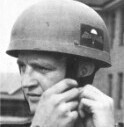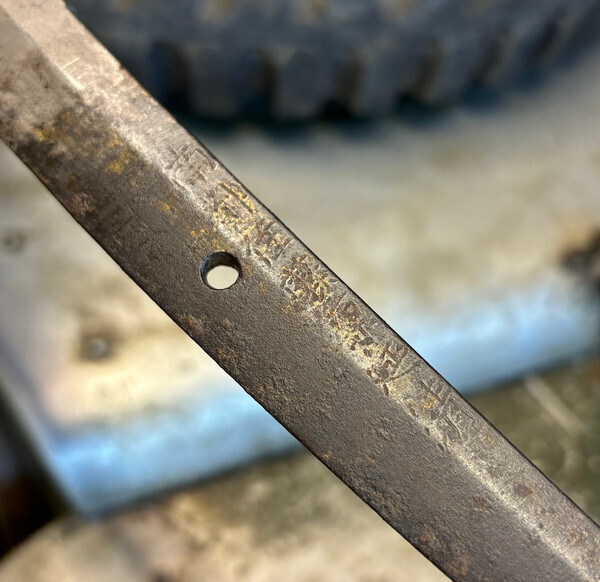-
Posts
101 -
Joined
-
Last visited
Content Type
Profiles
Forums
Events
Store
Downloads
Gallery
Everything posted by Fusilier
-

Gunto, Tag and Unexpected Iron Daisho Tsuba Set
Fusilier replied to Fusilier's topic in Translation Assistance
Thanks Jan, Great info, on the name, I once called one of these tags a 'surrender tag' and was mildly scolded for doing so, is it now the accepted name for these things? Cheers David -

Gunto, Tag and Unexpected Iron Daisho Tsuba Set
Fusilier replied to Fusilier's topic in Translation Assistance
Thank you Moriyama San, Are you able to confirm Jan's translation of the original owners name: 皆川喜德 = Minagawa [not sure how to read the given name, could be Yoshinori or Nobunori] ? Cheers David -

Gunto, Tag and Unexpected Iron Daisho Tsuba Set
Fusilier replied to Fusilier's topic in Translation Assistance
Thanks Maurice, Great spot, at first crack It looks identical to the one I have, but assuming one thing can't be in two places at once, its either a mass produced item or a fake assuming my seller didn't very generously purchase it and send it to me as a gift !! Given the age old wisdom that if it looks too good to be true it usually is, I'd go with the former explanation. Interestingly, I think the box is the giveaway here. On the example you've sent me from the pawn shop there are three small discolored marks on the velvet at the top left of the smaller Tsuba, the box I have doesn't have that or any of the other small distinguishing marks on the Pawn Shop example. If anyone knows more, or can translate what the inscription says, I'd be delighted to hear. Thanks again Maurice -

Gunto, Tag and Unexpected Iron Daisho Tsuba Set
Fusilier replied to Fusilier's topic in Translation Assistance
-
G'day Guy's, I purchased for resale recently this Showa Era Gunto, having been sent a couple of very poor photographs of the sword. I was genuinely surprised at how nice it was when it arrived with matching numbered shin gunto mountings, I wasn't expecting it to be accompanied by a boxed Iron Daisho Tsuba set, which in addition to containing two Tsuba for a set of blades, also contained a tag which presumably was once fitted to the sword. I was hoping you guys could help me answer a number of questions which spring to mind. Firstly, and obviously, what do the mei on the sword say? I assume the painted symbols on the reverse face are numbers from its production. Secondly, what does the tag say? Thirdly, can anyone tell me anything about the boxed Tsuba, including a translation of the inscription on the large one? Finally, has anyone seen a pairing like this before, of a wartime forged blade and an Iron Daisho Tsuba set? I'd be hugely grateful for any insights.
-
Thanks Carlo, I agree and of course you're correct, but I think it'd be interesting to determine whether it was shot or shell and on the balance of probabilities we can make some some informed speculation. Given where it was sourced it's most likely to have been an Australian's souvenir and I think the re-covered leather Saya may indicate that it continued in use after it was struck. Cheers David
-
I reckon for 7 bucks, its worth finding out, even if its only to satisfy my own curiosity.
-
Cheers Ron, That looks far more like the damage a HV round would cause, whats the diameter of that hole and have you any pics of the sword that was in the saya?
-

Translation Help: Battle Damaged Blade
Fusilier replied to chgruener's topic in Translation Assistance
Thanks for sharing Christopher, great sword and very evocative. As I said on my own thread, I'm no forensic ballistics expert but that doesn't look like a bullet strike to me, its looks far more like shrapnel damage and unfortunately for the officer carrying it, he'd almost certainly have caught some of it. I'm sorry I can't help with the translation but I'm sure one of these guys will be able to assist, they are guns when it comes to translating these inscriptions. -
Nice try Jay !! The Saya cover has certainly been replaced post damage, I can feel the impact damage through the leather but I don't want to try and remove it as I'm not sure I'd be able to get it back on. A .45 strike is certainly a possible explanation but I thought that given the angle of the strike into the Saya and the damage on the sword that it was most likely shrapnel damage. Of course that assumes that the officer was upright at the time of the impact. If he was crouching, bending or lying prone, the projectile would have impacted at that angle so I suppose that's not really any sort of determinant. Col and Rob are of course correct , we'll never know. Speaking as an old soldier though, whoever he was, he was bloody lucky that the blade caught it and didn't shatter. Given how superstitious soldiers tend to be, I'd put money on the fact that he hung on to that lucky bit of kit for the rest of his service and gave it up very reluctantly. I carried the same utility pouch for years with a hole through both sides (the one under my left arm in this shot) !!
-
G'day Jan, Many thanks for that.
-
Good point John, I certainly haven't, as the scenes of crimes teams used to say in NI 'every contact leaves a trace'.
-
-
Close ups of the impact mark. I haven't tried to remove the leather saya cover to inspect the damage on the wooden body but I can feel the shape through the leather. Also attached an image of the inscription.
-
G'day Fella's, I have two questions about this sword which I'm hoping you can help me with. I purchased it for resale over a decade ago from a retired NSW Police Superintendent. He believed that the blade had been struck by a bullet, but I'm not sure. I think if it'd had been hit by a HV round the blade would have shattered and a LV round would not have resulted in the sort of damage that is visible on the blade. The shape of the impact mark and the angle of the strike on the saya and blade indicate that if it was being carried at the time it was struck then the impact came from above and at an angle. That, and the shape of the impact mark, lead me to believe that its a shrapnel impact. Although I served for 3 decades I'm not going to claim any specialist knowledge of forensic ballistics other than the application of common sense. I was hoping that someone may have seen this sort of damage before or even a recorded HV strike on a gunto for reference. Although it is difficult to show in photographs, the impact has visibly and slightly 'bulged' the opposite side of the blade. My second question is far more mundane and obvious. I was hoping someone might be able to translate the inscription on the nakago. I can see a partial Seki stamp above the inscription which I understand indicates it was produced between 1940 and 1942 but any other information would be most welcome.
-
G'day Everyone, I purchased this sword recently along with a US M1 Bayonet from the family of a nurse who during WW2 worked at a US Military Hospital in Townsville in Queensland. She told her family that she'd been given the bayonet as a Valentines Day gift in 1945 but her grandson had no idea how she acquired the sword. I'd be grateful for any information that you fella's can glean from the photo's.
-
Thanks Piers, much appreciated
-
Thanks mate, I think I've found the clan which appears to be Li or 井伊氏
-
-
G'day Guys, I was hoping that someone may know something about what I believe is a family 'mon' embossed onto the hilt of this fairly ordinary Parade Sabre I recently purchased with the intention of listing. I realise it's a bit of a long shot, but nevertheless felt it was probably worth asking the question. Cheers David
-
Thanks John, That's definitely the one. I suspect, but I suppose we will never know, that it was attached as its the most basic (and cheapest) sword knot you could find. I suppose, its possible the original Japanese owner came across one, in the Philipines or the like, but I doubt it. I've said it before, and it bears repeating, the breadth of knowledge and experience on this site and the members generous approach to sharing it, are unparalleled. With reference to the smith Kanemune. I've attempted to research him and have found an arsenal sword smith from Seki in Gifu prefecturea called Kanemune, son of Fukumoto Amahide. It seems he worked with and signed many works for his father and is reported to have made both gendai and Showato blades. He's also reported to have used a ‘Chimata’ stamp which I believe may indicate that the maker was a member of the Gifu Sword Maker's Guild although I cant see evidence of it on this blade. Do you know any more? Thanks again Mate. Cheers David



























